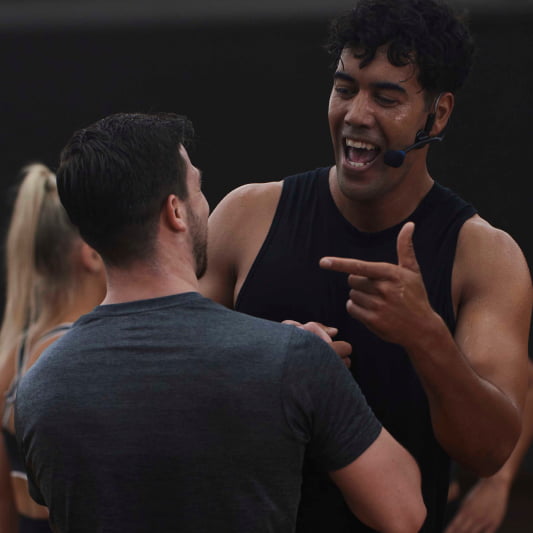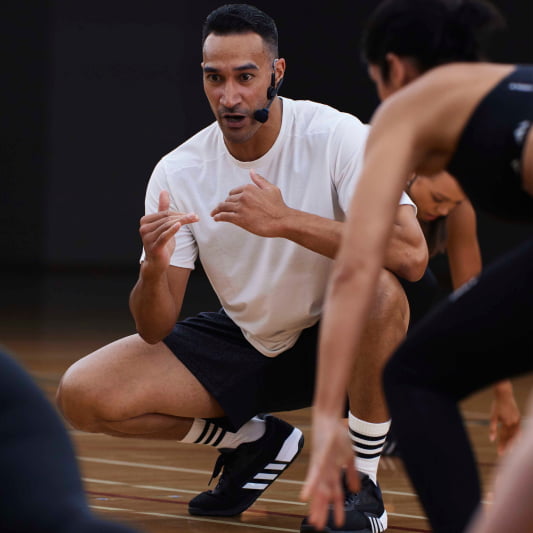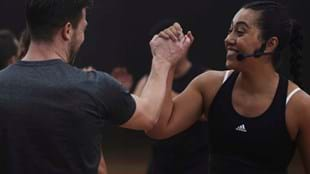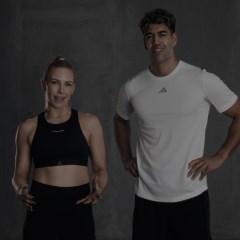“What I love about teaching is the opportunity to make people fall in love with fitness, and movement in general,” says Les Mills Presenter Khiran Huston.” I think it’s really cool that providing a good experience for people can instil this love of movement. And it doesn’t have to be high intensity – just getting people to feel happy about moving their body in whatever way makes them feel good.”
The group training Instructor’s role in helping retain new members is crucial. Consider that, according to statistics, 42% of new members quit exercising within 30 days of joining; and 50% of new members with little to no exercise experience are at the highest risk of dropping out. Of all new members who leave their club, 57.5% do so because of low added value, as well as bad guidance and induction¹.
You know who the new people are in your class. They’re the ones right at the back, strategically positioned close to the exit. The people who have the newest trainers. The ones who have a slightly crazed look of panic on their faces. And these people are the ones you need to pay most attention to. The front row will still be with you in December. The back row? Not guaranteed. Luckily, we’ve got the following key steps to help you transform your new person into your Monday night stalwart.

- GET YOUR INTRO RIGHT
Asking “Is anyone new?” is a sure-fire way to make new members feel self-conscious. They’re likely already feeling out of place and being the only person to put your hand up can feel excruciating.
A better approach is to script your introduction to assume that you always have someone new in the class. Give a brief overview of the workout and explain what equipment (if any) they will need. Make them feel special – “It’s great to see some new faces as well as my regulars” is a good way to welcome people into the class. And if you’re launching a new release, emphasize that this is a great time to join since the workout will be new for everyone!
- GIVE PEOPLE AUTONOMY OVER THEIR WORKOUT
The secret to looking after newcomers is to keep their confidence high. Allow your new members to manage both the duration and intensity of their training. Trying anything new can be intimidating, and the key to success is to start slow.
Use the SMART START guidelines to help beginners build the fitness habit. For the newcomer to exercise, completing two sessions a week as a starting point is plenty – with three being a bonus. It can be easy to forget that the weekly workout volume of the average Instructor is huge! Moving from a relatively sedentary lifestyle to a more active one can be a massive step for people. With this in mind, encourage them to dip their toes into new sessions, rather than trying to complete a workout every day – which may feel unachievable for some. And if you’ve got new people coming to your HIIT classes, share the research around the optimal amount for maximum benefits.
- FOCUS ON CLEAR COACHING – ESPECIALLY LAYER 1
Layer 1 is the most important layer for new people, because it tells them what to do and how to do it. Don’t get too excited and skip this important layer because you want to show off your ingenious Layer 2 cues or incredibly motivating Layer 3. If they don’t know how to execute the movement, they’re going to feel frustrated and the rest of your cues will be noise. Look out and see what’s going on in the room. If you need to reinforce Layer 1 many times, that’s totally okay!

- CREATE A JUDGEMENT-FREE ZONE
Stepping into a group training class for the first time can be intimidating and unsettling. It can make people feel vulnerable, and there can be a high level of fear of being judged. As Instructors, it’s in our gift to turn this around, and make people feel amazing.
Otto Prodan explains how the Instructor at his first ever group training class did that for him: “When I went to that BODYATTACKÔ class, the Instructor made me feel seen, made me feel like I was okay. That I belonged. I didn't feel like I belonged in the school. I didn't feel like I belonged at home. I wasn't feeling good in my body. And I was being told that what I was doing was wrong. But in the gym, in that class, it didn't matter and the Instructor didn't care. I was being encouraged to be myself, to be as flamboyant as I liked, to wave my hands in the air and enjoy myself. I felt like I could express myself in a way I couldn’t in other parts of my life.
He adds: “When I teach my classes, I want people to have that same feeling that the BODYATTACK Instructor gave me. It doesn't matter who you are. It doesn't matter your fitness level. It doesn't matter what's going on at home. You can come here and have a good time and feel good in your body. No judgement.”
- FOCUS ON CONNECTION
Of all the 5 Key Elements, Connection is probably the most important when it comes to retaining members in your classes.
Reagan Kang says the reason people return to his sessions is: “Because I focus a lot on connection. I focus on making people feel like they’re the only person in the room. I learn names and I try to talk to everyone in the room, to make them feel connected so that the next hour is just you, me, the music and the workout. I want them to forget everything else that’s going on in their lives so we can just focus on what we're doing. Then when they leave the class, they feel a lot better about themselves.”
- CELEBRATE THE IMMEDIATE WINS
The people in front of you are likely driven by a wide variety of motives. While some goals can take longer to achieve, it’s worth celebrating the immediate wins we get from exercising. Things like better mood, improved sleep, de-stress, the endorphin high. The cool-down is the perfect opportunity to celebrate everybody’s efforts and remind them of the instant benefits they will receive from the workout.
“I never think about the aesthetic – although I know it’s often the initial motivator for people to start coming to the gym,” says Khiran. “I’m all about the feel, so I try to break down the way something feels in the body and get members to connect to that: whether it’s the feeling in the moment, or afterwards.
“In the moment they might be thinking, ‘Oh woah, I hate you right now Khiran,' or 'Please stop shouting at me,' (especially in a HIIT class) but then afterwards they experience those feelings of elation, joy or relief – like, ‘I had a really hard day and I was really stressed out, but I now I feel really good.’”
REFERENCES
- Armitage, C. J. (2005). Can the theory of planned behavior predict the maintenance of physical activity. Health Psychology, 24(3), 235–245.








